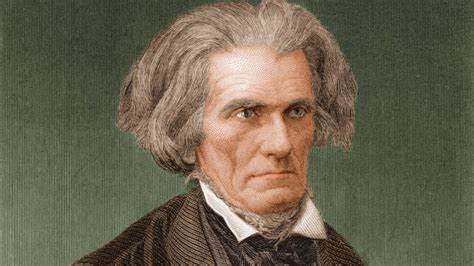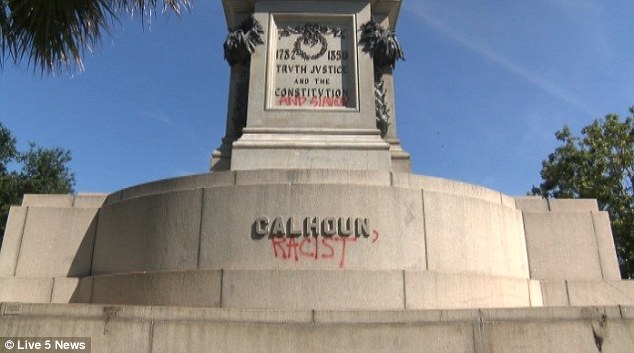*
Editor’s Note: Hope is a frequent very knowledgeable caller of Politics Done Right always with an informed perspective. Here she gives more context to the removal of a Confederate statue.
Hope Bleecker studied Calhoun in some detail as a student at Clemson University, which is built around his former home and plantation which was called Fort Hill. She is a former AICP City Planner & Owner/Trader of Environmentally Friendly Investments at Elpidos, LLC

Charleston, South Carolina. Mayor John Tecklenberg recently held a press conference at the base of the grandiose 115-foot tall monument of former United States House Representative, Vice President, Senator, and Secretary of War, John C. Calhoun, to announce that the iconic statue would be removed. The announcement followed weeks of Black Lives Matter protests and a night of rioting in the city’s historic district. Few South Carolinians outrank the confederate statesman, whose replica has stood atop a tall pedestal in Marion Square Park for 124 years. His statue is cast in bronze and stands cloaked in a cape holding a scroll in his left hand looking out over the city. It has always been a stunning confederate symbol against the backdrop of the South Carolina Military Arsenal, which was built in 1829 to patrol the movement of blacks in and out the City.
Calhoun was born in 1782, in the age of the Confederate States of America, an era which would be the defining identity of his political career. He was an influential federal statesman for almost forty years. His parents moved along free lands from Pennsylvania to eventually settle in the upstate region of South Carolina as slave-owning planters. Demonstrating aptitude as a youngster, he eventually studied law at Yale College where he graduated with distinction in 1804. He is considered by historians to be a brilliant orator as well as a courageous defender of the agrarian south, which was heavily funded by British and European banks eager to keep rice and cotton trades alive in America. As a US Senator his speeches stoked controversy in 1837 when he described slavery as “a positive good” and included the definition of persons of color as “mentally inferior”. Slavery had been established for 160 years in the Carolinas and Calhoun attempted to fend off abolitionists by arguing that blacks were better off as slaves in the south than they were as free men in the north. In addition to being widely known for his support of slave capitalism, he is also remembered for his idea that states should have the ability to interpose federal government laws that were unconstitutional, otherwise referred to as states’ rights.

The Calhoun monument was first placed in 1887, 27 years after his death. At the time, Charleston citizens were dealing with Jim Crow segregation laws and were still in the process of recovering from the devastation of the civil war. When it was first placed on the site, articles were published in one local newspaper calling the monument an “Abomination” and reminders were sent to readers which said, “Do Not Panic…Slavery has Ended”. Recently in 2015, the word “Slavery” was painted onto Calhoun’s list of credits after nine parishioners at Emmanuel African Methodist Episcopal church were murdered by a young white supremacist man less than a block away from the statue. The monument also became a protest rally site after more unrest in 2016, following the brutal shooting death of Walter Scott by a white North Charleston policeman.
Removal plans are being met with resistance, as self-proclaimed historical scholars of confederate descent form Facebook Groups entitled “Protect Charleston’s History”. Some citizens argue that, regardless of any negative assessments of Calhoun, Charleston is a living museum and leaving the monument in place is a necessary part of history.
The decision to remove the monument is not so much about Calhoun’s personal achievements versus his defense of slavery. Many South Carolinians besides Calhoun can be blamed for economic oppression and social injustice which was served on black populations throughout history. However, there is no argument that Calhoun’s grandiose monument is now stripped of its iconic southern fortitude and is no longer appropriate to Charleston’s social and urban context. After the horrific murder of George Floyd, the Black Lives Matter movement grabbed the opportunity to shine a light, not only racism, but also on economic injustice during a time when all Americans are vulnerable to economic downturn and instability. What has finally changed is a true recognition of economic slavery and injustice.

Attitudes toward historic figures, icons, and symbols are always malleable and anything which affects the health and wellness of a population, especially in a climate of adversity, can be rendered invalid. Such was true of the swastika, the ancient symbol of wellness and luck in Indian culture. After its association with Hitler, it was forever scrubbed as a positive symbol.
Charleston is one of the best preserved and most historically significant cities in America. In times of tragedy, residents resiliently embrace change as fluidly as the tides which flow in and out of the city’s harbor. Removing the monument signals important compliance with environmental justice, which is the idea that an unfavorable condition should not outweigh the health or wellness of those who share space with it. Additionally, removing the historic statue from a public space does not mean that history is rewritten or forgotten. It means that the act of removing the statue is the more important part of history.
Viewers are encouraged to subscribe and join the conversation for more insightful commentary and to support progressive messages. Together, we can populate the internet with progressive messages that represent the true aspirations of most Americans.

For removal, I’d go with a 55 gallon drum sized thermite device. That’d take care of the statue and pedestal without a lot of labor.
Molten iron finds its own justice.
And once melted down, it’d find no new home for monsters to worship it.
Then, replace the abomination with someone noteworthy, rather than infamous. South Carolina and Charleston has plenty of them throughout history that weren’t motherless bastards.
Well, off to schedule a send of a Twitter question to the imPOTUS. I am going to ask, what is he going to do once he’s gotten his entire Secret Service security detail detachment quarantined.
Egberto, a couple of clarifications, Calhoun was born in 1782 not 1872. He passed away in 1850. He studied a general curriculum which included law at Yale and was educated at Litchfield in CT, which was the first law school in the Untied States. He was admitted to the bar in 1807.
Thanks for fixing it for me!!